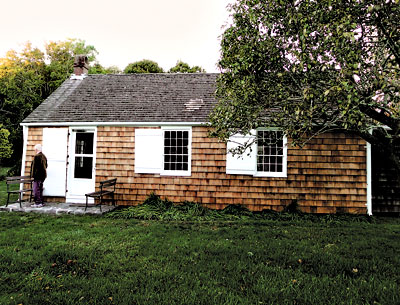19th-Century Schoolhouse to Be Donated

An Amagansett schoolhouse, built in 1802 by Samuel Schellinger and thought to be the oldest on eastern Long Island, is to be donated to the hamlet’s school district and relocated to the present-day school grounds. Eleanor Tritt, the district superintendent, made the announcement at a school board meeting on Tuesday. The building is on the Atlantic Avenue property of Huntington and Adelaide Sheldon. Mr. Sheldon, who is known as Skip, showed the building to a reporter and others on Tuesday. He said they had decided to donate it last summer after discussing it for a few years. That the schoolhouse is to be moved is a familiar story. It was originally on “Amagansett Street,” now Montauk Highway, approximately opposite today’s school building. It was moved to the west side of Atlantic Avenue, at what is now the southern part of the East End Cemetery, in 1864, and moved again in 1881, when it was auctioned to Marcus Hand. Mr. Hand sold it to Capt. Joshua B. Edwards, who moved it across the street to his back yard, which is now part of the Sheldon property. Capt. Edwards’s son, Dr. David Edwards, handled the sale to Mr. Sheldon’s mother, Magda Sheldon, in 1936 or ’37. At that time, the building was filled with fishing nets, a dory, and flensing knives, which were used to cut whale blubber. “This building was used by the girl scouts in the late ’40s as a meeting house,” Mr. Sheldon said. “There were some five or six girls who were committed to it, and not many more. They all went to the school here in town. That was the last public use that this building had.” According to the 1997 book by Carleton Kelsey and Lucinda Mayo, “Images of America: Amagansett,” the school year “was often determined by the cycles of land and sea harvests.” The book quotes Samuel Schellinger’s brother Sylvester, saying he taught “30 scholars and expect more” at the schoolhouse. “They give me $2 to $2.50 per scholar. I pay $20 per year for house and garden. Cheap enough.” Mr. Schellinger, a millwright, built the Pantigo and Hayground windmills in East Hampton, and possibly the Beebe windmill in Bridgehampton, said Hugh King, East Hampton Village historian and director of its Home, Sweet Home Museum. Touring the schoolhouse on Tuesday, Mr. King shook his head in wonder. “There’s nothing like it,” he said. Moving the building to the school’s grounds will be subject to a State Environmental Quality Review Act assessment and approval by the New York State Education Department. Pending these approvals, the one-room schoolhouse will be put to rest in front of the school, near the playground and shrubbery. “We’re very excited about the possibility of having it reside here,” Ms. Tritt said, “for the historic value to our community.”
